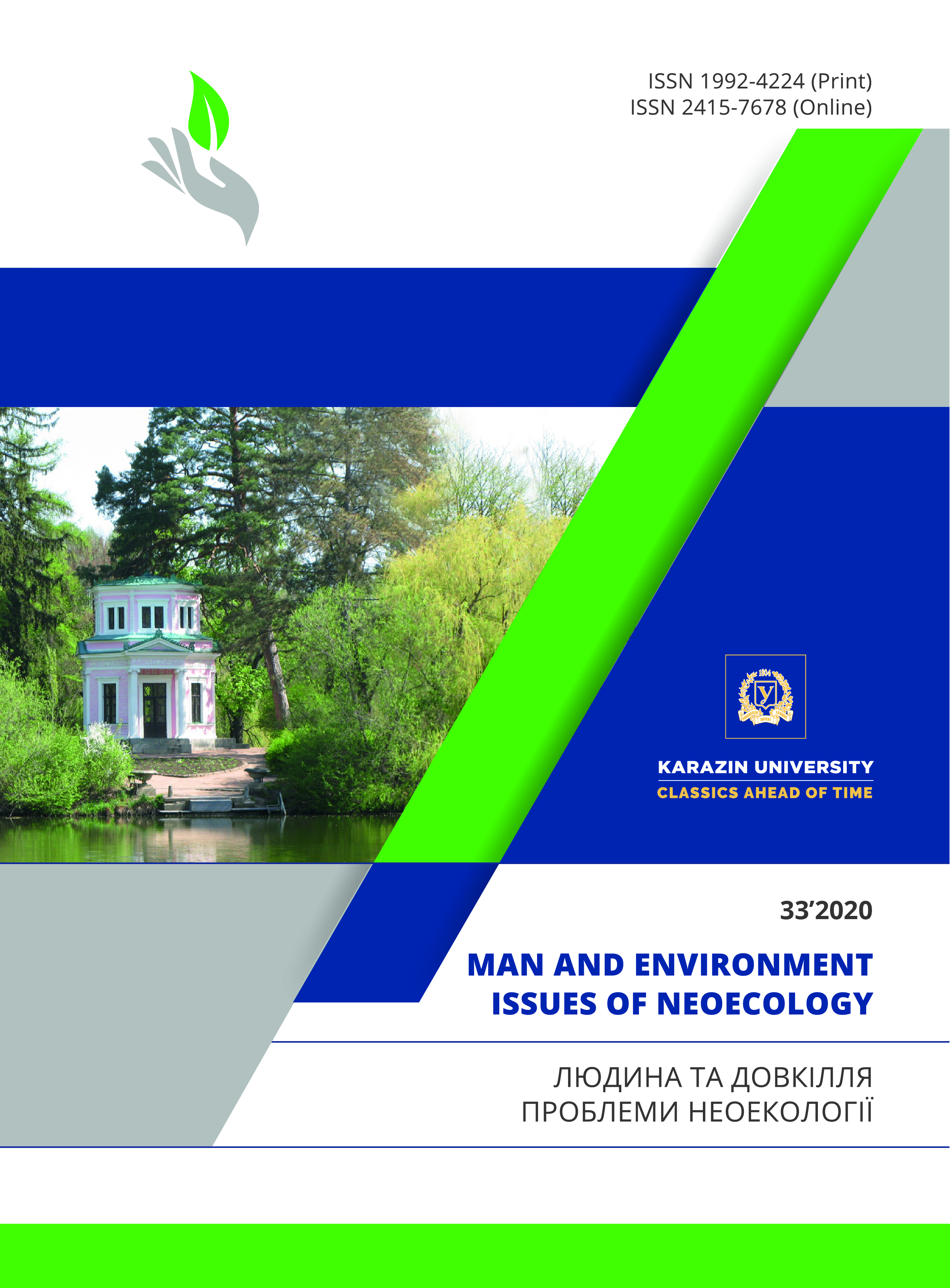Просторово-часова варіація забруднення атмосферного повітря м. Харків дрібнодисперсним пилом фракції РМ2,5
Анотація
Мета. Виявлення просторових і часових варіацій забруднення атмосферного повітря урбогеосистем з високим ступенем антропогенного навантаження дрібнодисперсним пилом фракції РМ2,5 (на прикладі м. Харків).
Методи. Відкрита платформа онлайн-моніторингу «Air Pollution», вимірювання РМ2,5 здійснювалося пиломірами «7bit Pollution Monitor», статистичні.
Результати. Моніторинг РМ2,5 в атмосферному повітрі м. Харкова проводився у період з 01.08.2019 до 01.04.2020 на 6 контрольних точках у різних районах міста. Було опрацьовано 28119 проб. Джерелом отримання даних щодо масової концентрації РМ2,5 у повітрі слугувала відкрита платформа онлайн-моніторингу «Air Pollution». Для визначення дотримання гігієнічних норм вмісту дрібнодисперсного пилу фракції менше 2,5 мкм були використані порогові концентрації, рекомендовані ВООЗ. Оцінка рівня запиленості повітря та його небезпеки для здоров’я населення проводилася відповідно до міжнародної шкали рівня забруднення повітря РМ2,5 за Індексом якості повітря (Air Quality Index, AQI). Із загального обсягу досліджуваної вибірки для 17,4% випадків (4905 із 28119 значень масової концентрації РМ2,5) зафіксовано перевищення ГДК за ВООЗ. Загалом відповідно до шкали AQI, у переважній кількості випадків вміст РМ2,5 в повітрі варіюється від низького до помірного. Найвищий рівень запиленості повітря характерний для точки №1 (Аптекарський провулок, 9), що може бути обумовлено її розташуванням на територій із високою інтенсивністю руху автотранспорту. У ході аналізу простежено добову, тижневу та сезонну динаміку вмісту PM2,5. Сезонні та добові варіації вмісту РМ2,5 у повітрі м. Харкова залежать від зміни погодних умов (кількості опадів, швидкості вітру та ін.), рівня завантаженості автомобільних доріг і режиму роботи потенційних стаціонарних джерел забруднення.
Висновки. Отримані результати дають основу для подальшого дослідження кореляції вмісту РМ2,5 у повітрі зі ступенем впливу різних природних і соціально-економічних факторів території, а також із рівнем захворюваності населення.
Завантаження
Посилання
Environment of Kharkiv region: a statistics digest. (2019). Main Department of Statistics in Kharkiv Region. Retrieved from http://kh.ukrstat.gov.ua/categories/1036-publikatsii-prezentatsiini-versii/ekonomichna-statystyka/ekonomichna-diialnist/navkolyshnie-seredovyshche/3112-navkolishne-seredovishche (in Ukrainian).
Report on the state of the environment in Kharkiv region in 2018. (2019). Department of Ecology and Natural Resources of the Kharkiv Regional State Administration, Kharkiv. Retrieved from https://kharkivoda.gov.ua/content/documents/1006/100511/Attaches/regionalna_dopovid_2018.pdf
(in Ukrainian).
Monitoring of air pollution in Kharkiv. (2020). Kharkiv Regional Center for Hydrometeorology: official information server: website. Retrieved from http://kharkiv.meteo.gov.ua/monitoring/ (in Ukrainian).
DSP-201-97. (1997). State sanitary regulations for protection of atmospheric air of settlement areas (from pollution with chemical and biological substances): adopted by the Order of the Ministry of Health of Ukraine dated on July 9, 1997 No. 201. Retrieved from https://zakon.rada.gov.ua/rada/show/v0201282- 97
(in Ukrainian).
Slobodianyuk, A. A., Garcia Camacho Hernan Ullianodt, Silva Rubio Luis Antonio & Vasylkivskyi, I. V. (2018). Investigation of aerosol pollution of Vinnytsia. Proceedings of the XLVII Scientific and Technical Conference of VNTU departments, Vinnytsia, 2018, March 14-23, (pp.1-5). Vinnytsia, Vinnytsia National Technical University. Retrieved from http://ir.lib.vntu.edu.ua//handle/123456789/22391 (in Ukrainian).
Nemenko, B. A, Iliyasova, A. D. & Arynova, G. A. (2014). Estimation of the danger degree of fine dust particles in the air. Bulletin of KazNMU, (3-1), 133–135. Retrieved from https://cyberleninka.ru/article/n/otsenka-stepeni-opasnosti-melkodispersnyh-pylevyh-chastits-vozduha (in Russian).
Ponomarova, S. D. (2019). Protection of atmospheric air from pollution by emissions of organic fine particulate matter generated in confectionery enterprises. (Master’s thesis). Research Institute "Ukrainian Research Institute of Environmental Problems", Kharkiv (in Ukrainian).
Effects on health of suspended particles. (2013). Implications for policy development in Eastern Europe, Caucasus and Central Asia. WHO Regional Office for Europe Newsletter. Copenhagen. Retrieved from http://www.euro.who.int/__data/assets/pdf_file/0007/189052/Health-effects-of-particulate-matter-final-Rus.pdf?ua=1 (in Russian).
Nevmerzhitsky, N. V. (2016). Methodology for assessing and predicting extreme air pollution on highways with fine particulate matter PM10 and PM2.5. (Master’s thesis). St. Petersburg. Retrieved from https://www.dissercat.com/content/metodika-otsenki-i-prognozirovaniya-ekstremalnogo-zagryazneniya-vozdukha-na-avtomagistralyak (in Russian).
Strelyaeva, A. B., Lavrentieva, L. M., Lupinogin, V. V. & Gvozdkov, I. A. (2017). Investigations of PM10 and PM2.5 particles level in a residential area located near industrial enterprises. Engineering Journal of Don, (2), 8. Retrieved from http://www.ivdon.ru/ru/magazine/archive/n2y2017/4238 (in Russian).
Air Pollution: website. Retrieved from https://www.air-pollution.ml (in Russian).
Nekos, A., Medvedeva, Y. & Cherkashyna, N. (2019). Assessment of environmental risks from atmospheric air pollution in industrially developed regions of Ukraine. Journal of Geology, Geography and Geoecology, 28(3), 511–518. Retrieved from https://doi.org/https://doi.org/10.15421/111947
Beketov,V., Yevtukhova, G., Lomakina, O. (2016) Analysis and assessment of the air pollution level of Kharkiv. Man and Environment. Issues of Neoecology, 26(3-4), 97–103. https://periodicals.karazin.ua/humanenviron/article/view/7759 (in Ukrainian).
Kulyk, M. I. & Ivah, U. A. (2019). Assessment of the atmospheric air quality within the main вus stations Kharkiv. Man and Environment. Issues of Neoecology, 31,117–129. https://doi.org/10.26565/1992-4224-2019-31-11 (in Ukrainian).
Lydina, V. І., Maksymenko, N. V. & Cherkashyna, N. I. (2019) Spatial distribution of air dust pollution in Kharkiv city. Environmental protection: Сollection of scientific articles of the XV All-Ukrainian Taliyiv scientific readings. Kharkiv, 2019, 124–125.
Directive 2008/50 / ЕС of the European Parliament and of Council of 21 May 2008 on ambient air quality and cleaner air for Europe. Retrieved from https://eur-lex.europa.eu/legalcontent/EN/TXT/PDF/?uri=CELEX:32008L0050&from=en
WHO Air Quality Guidelines for particulate matter, ozone, nitrogen dioxide and sulfur dioxide. (2005). Global update 2005. Summary of risk assessment. Geneva: WHO. Retrieved from https://apps.who.int/iris/bitstream/handle/10665/69477/WHO_SDE_PHE_OEH_06.02_eng.pdf;jsessionid=464F804B47551ECF18AC385034A07DB3?sequence=1
European Air Quality Index. GIS Map Application. European Environment Agency: website. Retrieved from https://www.eea.europa.eu/themes/air/air-quality-index
Weather archive in Kharkiv (airport). Weather Schedule rp5.ua: website. Retrieved from https://rp5.ua/ (in Ukrainian).
Climate of Kharkiv. Kharkiv Regional Center for Hydrometeorology: official information server. Retrieved from : http://kharkiv.meteo.gov.ua/klimat-kharkova/ (in Ukrainian).
Автори, які публікуються у цьому журналі, погоджуються з наступними умовами:
- Автори залишають за собою право на авторство своєї роботи та передають журналу право першої публікації цієї роботи на умовах ліцензії Creative Commons Attribution License 4.0 International (CC BY 4.0), котра дозволяє іншим особам вільно розповсюджувати опубліковану роботу з обов'язковим посиланням на авторів оригінальної роботи та першу публікацію роботи у цьому журналі.
- Автори мають право укладати самостійні додаткові угоди щодо неексклюзивного розповсюдження роботи у тому вигляді, в якому вона була опублікована цим журналом (наприклад, розміщувати роботу в електронному сховищі установи або публікувати у складі монографії), за умови збереження посилання на першу публікацію роботи у цьому журналі.
- Політика журналу дозволяє і заохочує розміщення авторами в мережі Інтернет (наприклад, у сховищах установ або на особистих веб-сайтах) рукопису роботи, як до подання цього рукопису до редакції, так і під час його редакційного опрацювання, оскільки це сприяє виникненню продуктивної наукової дискусії та позитивно позначається на оперативності та динаміці цитування опублікованої роботи (див. The Effect of Open Access).





